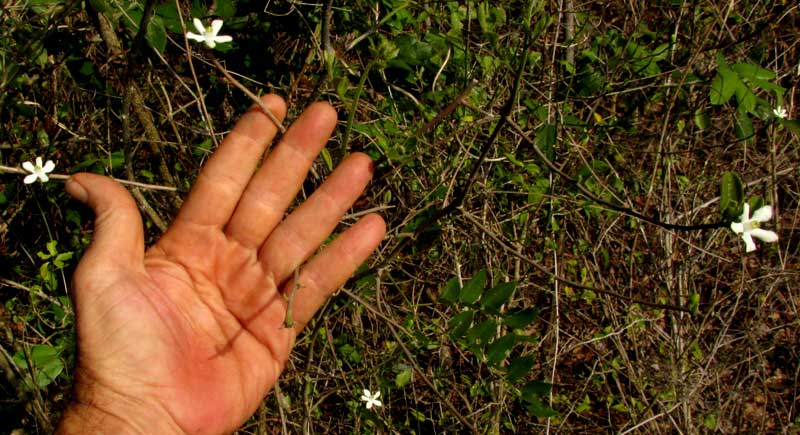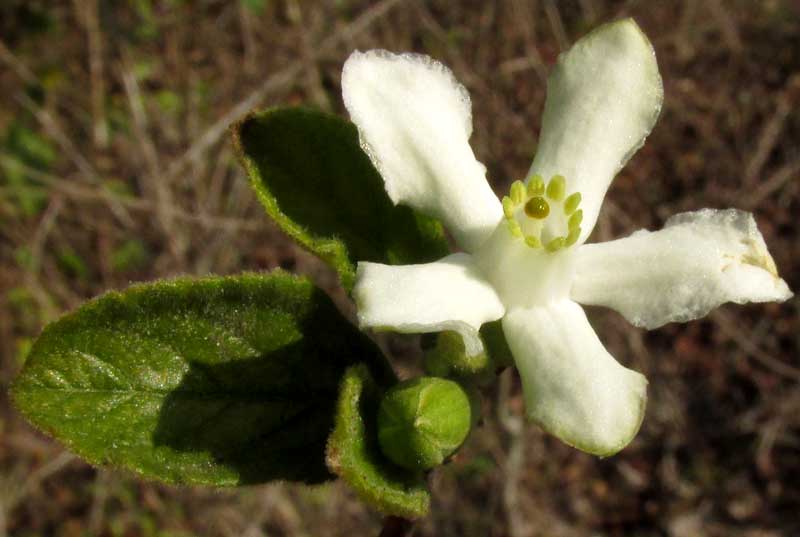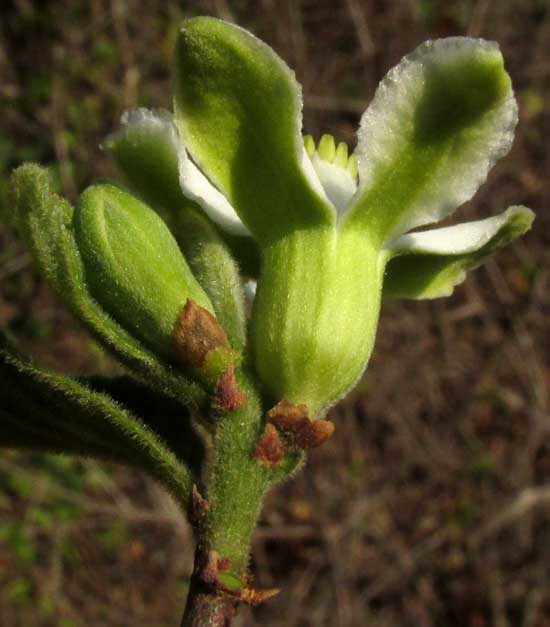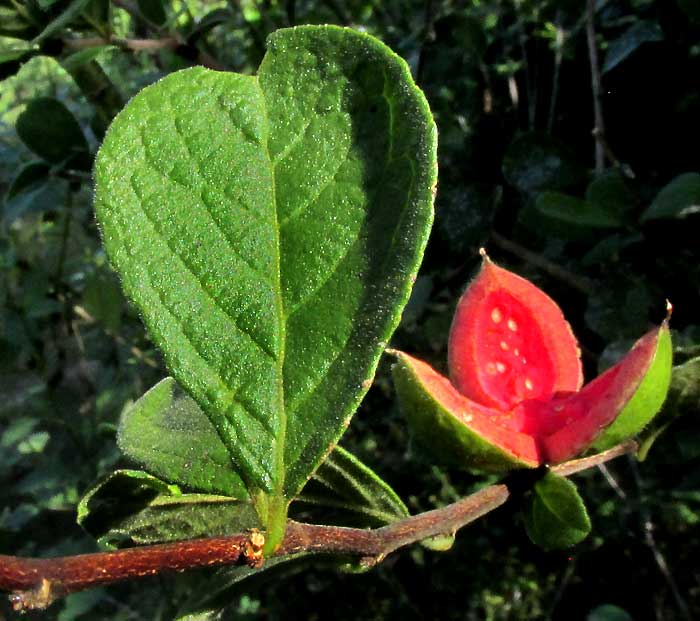Excerpts from Jim Conrad's
Naturalist Newsletter
from the March 11, 2018 Newsletter issued from Rancho Regenesis in the woods ±4kms west of Ek Balam Ruins; elevation ~40m (~130 ft), N~20.876°, W~88.170°; central Yucatán, MÉXICO
YUCATAN JASMINE
On my Sunday biking trip to the frutería in Temozón a leafless, shoulder-high bush or small tree turned up at the forest's edge bearing a diffuse constellation of small, conspicuously white flowers, the likes of which I'd never seen. Below, you can see the visual effect it made:

Up close, the flowers displayed the important diagnostic feature shown below:

The filaments of its ten stamens were joined at their margins, forming a cylinder around the female parts, or pistil. When the flower underside was looked at, another important feature turned up, shown below:

Instead of a white corolla arising from a green calyx, as I expected to see, the green calyx's lobes, or sepals, expand and become white, with there being no apparent corolla.
Because of the stamens' united filaments, my first guess was that this pretty species belonged to the big Hibiscus Family, but when I checked every Hibiscus Family genus known to occur in the Yucatan, nothing turned up like it. In the end, I had to use Colby University's online Plant Family Identification Key, which led to the strictly tropical Flacourtia Family, the Flacourtiaceae, and the further fact that nowadays the Flacourtia Family has been sunk into, of all things, the Willow Family, the Salicaceae.
With that insight it was easy to determine that our demure little tree or shrub was CASEARIA (SAMYDA) YUCATANENSIS, a species endemic only to the Yucatan Peninsula. It's not known well enough to have an English name, but in Spanish it's known as Jazmín Yucateco, which translates to Yucatan Jasmine. Unrelated to the real Jasmine, it's called that simply because its flowers are white and fragrant like Jasmine blossoms.
The Maya certainly know about this species, for three Maya names are registered for it. Probably its main fame with the Maya rests on its flowers being good sources of nectar for bees, plus they flower at a time of year when relatively few species are blossoming.
A 2014 paper entitled "Samyda yucatanensis: el jazmín yucateco" by Luz M. Calvo Irabién, and issued by CICY in Mérida, tells us of the presence in the flowers of an essential oil called farnesol. Farnesol is much used in the perfume industry to intensify sweet odors, plus to some insects it's a pheromone, or sexual hormone.
issued on January 2, 2020, from Tepakán, Yucatán, MÉXICO
YUCATAN JASMINE FRUIT
At the forest's edge beside the rancho's entry road, the interesting item shown below turned up:

A closer look showing the evergreen, alternate leaf's venation and rough, wrinkled surface, as well as the stem's covering of short, white hairs, and the open fruit, appears below:

The red thing at first was unintelligible to me. A close look is shown below:

Eventually I recalled from back at Ek Balam a small tree with fruits that tended to open into three shell divisions, with a seed inside coated with red matter, one of several species in the genus Casearia, which you can compare here. Knowing that, and that the genus Casearia produces fruits with the seeds attached to the fruits' walls, I realized that what's shown above is the empty husk or fruit wall, the seeds having been removed.
So, that was the key. It was another Casearia species, a species for which we've documented the fragrant, Jasmine-like flowers, but not the fruit. Earlier the name I learned for it was Samyda yucatanensis, but now I see that our Yucatan experts at CICY list our species in Casearia, so now we're calling it Casearia yucatanensis At the CICY website the Casearia yucatanensis page links to a photo showing an open fruit like ours, with a ball of yellowish waxy material resting in the middle, the waxy material containing seeds, apparently much desired by foraging ants.
Other Casearia species we've met displayed the distinctive feature of having shining or "pellucid" dots and/or streaks turn up among the leaves' intricate reticulations, when viewed with the Sun behind them. Leaves of our Casearia yucatanensis show plenty of pellucide dots, but only hints at streaks, as shown below:
